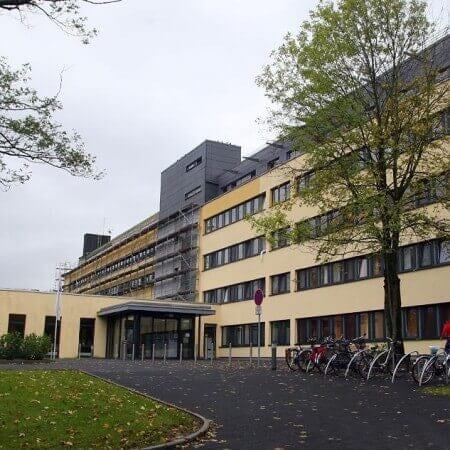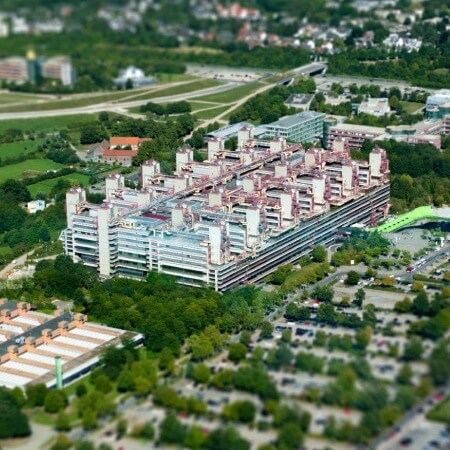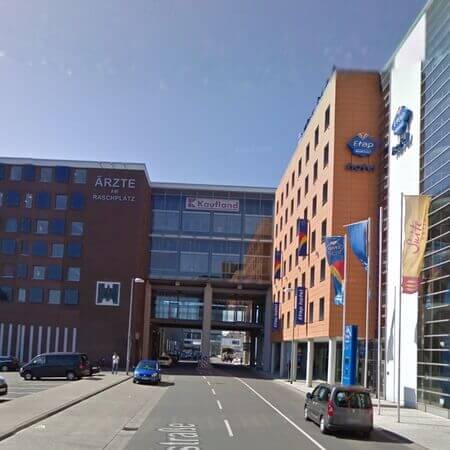Radiosurgery (Gamma Knife) for Acoustic Neuroma (vestibular Schwannoma) treatment in Germany
Treatment prices are regulated by national law of the corresponding countries, but can also include additional hospital coefficients. In order to receive the individual cost calculation, please send us the request and medical records.

Gamma Knife and Radiotherapy Center
The Gamma Knife and Radiotherapy Center specializes in the stereotactic radiosurgical treatment and stereotactic radiotherapy for benign and malignant tumors of the head and neck, vascular malformations, as well as metastases in various organs (for example, in the liver, lungs, spine). The center has state-of-the-art equipment for stereotactic radiosurgery and stereotactic radiation therapy – Perfexion Gamma Knife and Axesse Linear Accelerator. The center also has innovative technologies of targeted radiotherapy, thanks to which healthy tissues can be completely removed from the radiation zone. At the same time, tumors and their metastases can be removed with an accuracy of up to 0,3 mm.



Gamma Knife Center
The Gamma Knife Center specializes in cancer treatment. The medical facility was founded in July 1998 and currently has the status of one of the most respected and experienced in the field of its specialization. The patients are treated in close collaboration with experts in neurosurgery and nuclear medicine. For all the years of their clinical practice, the center's doctors have cured thousands of patients with cancer pathologies of varying severity.


Gamma Knife and Radiotherapy Center
The Gamma Knife and Radiotherapy Center offers the full range of medical services in its field of competence. The treatment begins with an individual consultation and the comprehensive diagnostics, while the therapy is followed by all the necessary measures for follow-up care and consolidation of the result. The irradiation is carried out using the innovative Gamma Knife ICON, the characteristics of which ensure the successful removal of tumors up to 3 cm in size without damaging the surrounding healthy tissues. The highly qualified doctors of the center have many years of clinical experience and excellent skills in using this progressive system, so the patient can be sure that he will get the optimal result.


Until recently, acoustic neuromas were mainly treated with surgical techniques. Surgery was considered the very first treatment option, and all other treatment methods were used only if surgery was contraindicated for a patient. But today, approaches to treating patients with this disease have changed. Gamma Knife radiosurgery is being increasingly used instead of surgery. This treatment approach allows doctors to destroy the tumor with the use of non-invasive techniques without any pain and without the risk of developing surgical complications. Patients do not need to stay at a hospital and undergo rehabilitation. In most cases, acoustic neuromas can be treated in a single session.
The technique is widely used in the world and is successfully applied in several large hospitals in Germany. You can visit this country to get top-class medical care. You are welcome to use the Booking Health service to find the cost of treatment in Germany and choose a medical care program.
Content
- What is an acoustic neuroma?
- Treatment principles
- How are acoustic neuromas treated with radiosurgery?
- What is the process of treatment?
- Treatment results
- Hearing preservation
- Benefits of Gamma Knife treatment
- Where to undergo acoustic neuroma treatment?
What is an acoustic neuroma?
Acoustic neuromas are slow-growing tumors that develop in the internal auditory canal, in the cerebellopontine angle, inside the cochlea, and in the labyrinth. When reaching large sizes, acoustic neuromas can compress the brain stem and therefore threaten the patient's life.
The tumor develops from the Schwann cells of the vestibular part of the vestibulocochlear nerve. They account for up to 6-7% of all intracranial tumors. These neoplasms are most often diagnosed at the age of 20-40 years.
Most tumors are unilateral. Approximately 5% of the neoplasms are bilateral and are usually associated with type 2 neurofibromatosis.
The main symptoms are as follows:
- deterioration of hearing function;
- functional facial nerve disorders, which lead to a deterioration in the mobility of the facial muscles;
- dizziness;
- vestibular disorders;
- noise in ears.
Large tumors may cause hydrocephalus and brainstem compression, leading to symptoms such as paresthesia (unusual sensations) in the face and headache.
A brain MRI is used to make a diagnosis. This is the most accurate imaging method that allows detecting a neuroma, and clarifying its size and location.
The tumor usually grows slowly, at a rate of about 1-2 mm per year. In some patients, the neoplasm grows much faster. There are cases where acoustic neuromas increased to 3 cm in 12 months. But the chances that it will stop growing or begin to shrink are very low, so when a tumor is detected, patients are treated to eliminate it, reduce it, or at least stabilize its size.
Treatment principles
After confirming the diagnosis, the following three tactics of patient management can be used:
- medical supervision with regular brain MRI scans and conservative therapy to relieve symptoms;
- radiosurgery;
- operation.
When a patient is under medical supervision, an MRI scan will be conducted once every six months for the first 2 years, followed by another scan after 2 years, and if the tumor does not grow, then a life-long examination will be indicated once every 5 years.
Should treatment be required, it will include surgery or radiosurgery. These techniques are considered comparable in terms of their effectiveness.
How are acoustic neuromas treated with radiosurgery?
The term "radiosurgery" was introduced into clinical practice by the Swedish neurosurgeon Leksell, the developer of the Gamma Knife system. It means the precise exposure to radiation that allows doctors to destroy the tumor with a single dose. The rays are sent to the target from different directions, so healthy tissues of the brain and ear do not receive a large dose of radiation, but all the rays converge on the tumor.
Radiosurgery has been used in acoustic neuroma treatment since 1969. The first radiosurgery units were imperfect, but today irradiation is becoming more accurate and safer. With the Gamma Knife, doctors achieve tumor control in almost 100% of cases and preserve the function of the trigeminal and facial nerves with rates of 92-100% and 94-100%, respectively. Hearing loss after surgery still remains a problem, as two-thirds of patients suffer from this complication. Advanced medical centers, however, use special radiation protocols that preserve hearing in more than 80% of patients.
In the original version, a helmet is used for radiosurgery to treat acoustic neuromas. It is attached with screws to the skull. The accuracy is the same as in stereotactic surgery, namely 0.3 mm. In the 80s, doctors began to use a mask instead of a helmet. The exposure accuracy remained at an acceptable level, namely about 1 mm.
Many modern hospitals in Germany use cutting-edge types of Gamma Knife units. They are even more accurate and involve the use of a frameless stereotactic system. The error during irradiation does not exceed 0.3 mm.
Although radiosurgery usually involves the complete destruction of the tumor in a single procedure, it is not safe to irradiate large tumors in this way. In such cases, several Gamma Knife treatment sessions may be required. This treatment option is called multisession radiosurgery.
What is the process of treatment?
The treatment process is as follows:
- patient immobilization with an individual mask;
- an examination to determine the exact tumor location, for example, computed tomography;
- combination of images obtained by different methods;
- planning of exposure to radiation;
- the last stage of the treatment is an irradiation procedure, after which doctors may administer hormonal drugs to a patient to relieve inflammation and swelling.
The irradiation procedure itself takes a minimum of time. The duration differs depending on which model of Gamma Knife is being used. Irradiation usually takes about half an hour.
Treatment results
The goal of Gamma Knife radiation therapy for a neuroma is to control tumor growth. It means that there is no need for microsurgical removal in the near or distant future.
Growth control is considered to not only reduce but also stop acoustic neuroma growth.
Changes after the Gamma Knife treatment do not appear immediately, but gradually. They are fixed during a period ranging from six months to one and a half years. With follow-up CT scans, doctors can see the formation of a zone of necrosis (tissue death) in the center of the tumor. It is surrounded by a zone of increased accumulation of a contrast agent, which indicates inflammation. During this period, the tumor may increase slightly in size, but this is not a true growth, but rather an edema associated with an inflammatory reaction.
Previously, doctors perceived these changes as a continuation of tumor growth. They performed surgery to remove the neoplasms. But further studies have shown that it is not only pointless to operate on such patients, because over time the tumor size will decrease on its own, but also unsafe. Post-radiation tissue changes increase the risk of surgical complications such as facial paralysis, hearing loss, and brain hemorrhages or infarctions that lead to disability.
Therefore, if the tumor grows a few months after the Gamma Knife treatment, patients are only monitored and do not have any surgery. If an enlarged neuroma causes symptoms, they will be eliminated with glucocorticoids. Over time, the acoustic neuroma decreases in size and all symptoms disappear. Not more than a year and a half later, the size of the tumor reaches that which it was at the time of irradiation or becomes even smaller.
Hearing preservation
If you are undergoing your treatment abroad, you can be sure that doctors will try not only to cure your neuroma, but also to preserve your hearing. It is already impaired in many patients at the time of treatment. It is important that these disorders are not aggravated as a result of the Gamma Knife treatment.
Doctors can reduce the radiation dose to the cochlea to 8 Gy to preserve hearing. Sometimes this is not possible. In this case, another option to reduce the risk of hearing loss is to use hypofractionated radiation therapy instead of radiosurgery. This means that a patient will have more than one Gamma Knife treatment session. Doctors will irradiate 3 to 7 times, depending on the size of the tumor. This tactic can be used even for small vestibular schwannomas.
Benefits of Gamma Knife treatment
Doctors at hospitals in Germany are increasingly preferring the Gamma Knife before microsurgical procedures. There are several reasons for this:
- the outcomes of surgical and radiosurgery treatments are comparable;
- the risk of hearing loss during the tumor microsurgical removal reaches 80%, while when using the Gamma Knife, the risk of hearing loss is 50%, and at the best hospitals in Germany, this indicator is 20%;
- the risk of damage to the facial and auditory nerves when performing surgery reaches 22%, and when using radiosurgery, it does not exceed 2% at the best hospitals in Germany;
- the treatment method is non-invasive and painless;
- no need for a hospital stay;
- no rehabilitation required.
The literature describes cases of malignancy of acoustic neuromas after using the Gamma Knife. This risk, however, is minimal and amounts to approximately 0.3%. In addition, cases of malignancy of the acoustic neuroma after the microsurgical removal of the formation are also described.
Thus, the Gamma Knife has many advantages over microsurgical removal when it comes to the treatment of acoustic neuromas. This is the first choice technique for tumor volumes up to 3.5 cubic centimeters. Even larger tumors can often be treated with the Gamma Knife, but in this case, doctors use hypofractionated regimens (multiple radiation sessions).
Where to undergo acoustic neuroma treatment?
You can undergo your treatment in Germany by choosing a medical care program through the Booking Health service. Specialized German centers use the latest radiation techniques that allow for curing the disease with a minimal risk of complications and with a good functional outcome.
There are a few reasons for you to undergo your treatment in Germany. These are as follows:
- high-quality equipment enables doctors to use state-of-the-art types of Gamma Knife units;
- comfortable treatment: physicians use frameless stereotactic systems, so there is no need to screw a rigid frame to the skull with screws;
- accuracy of irradiation reaches 0.3 mm;
- most patients manage to preserve their hearing, and many of them reach such a level of hearing preservation that a person can use the phone on the side of the tumor;
- low risk of complications from the brain, facial and trigeminal nerves.
You can choose a hospital in Germany on the Booking Health website. Here you can compare the cost of treatment in Germany in different centers to get an appointment at a medical facility at the best price. The specialists from the Booking Health company will help you to choose a center that specializes in acoustic neuroma treatment and achieves the best results in the fight against this disease. If you choose a medical care program through the Booking Health service, the cost of treatment in Germany will be lower due to the absence of additional fees for foreign patients.
Authors:
The article was edited by medical experts, board-certified doctors Dr. Nadezhda Ivanisova and Dr. Vadim Zhiliuk. For the treatment of the conditions referred to in the article, you must consult a doctor; the information in the article is not intended for self-medication!
Sources:

